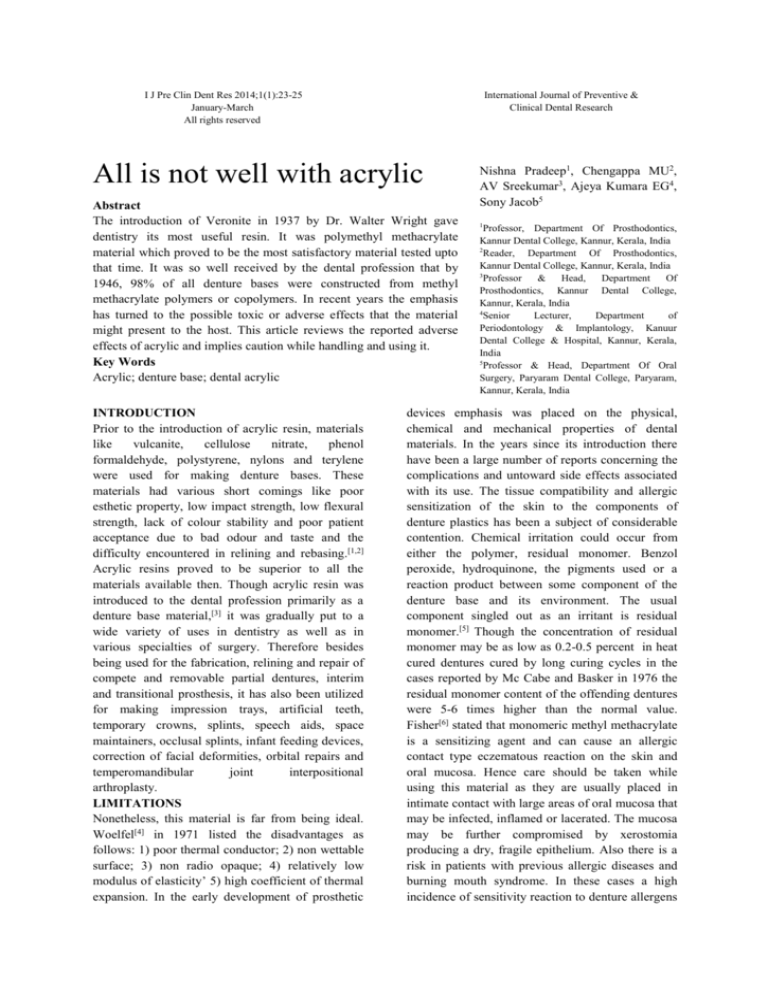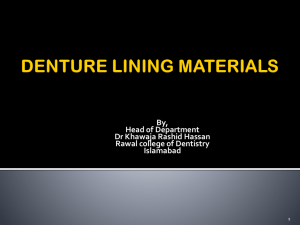
I J Pre Clin Dent Res 2014;1(1):23-25
January-March
All rights reserved
International Journal of Preventive &
Clinical Dental Research
All is not well with acrylic
Abstract
The introduction of Veronite in 1937 by Dr. Walter Wright gave
dentistry its most useful resin. It was polymethyl methacrylate
material which proved to be the most satisfactory material tested upto
that time. It was so well received by the dental profession that by
1946, 98% of all denture bases were constructed from methyl
methacrylate polymers or copolymers. In recent years the emphasis
has turned to the possible toxic or adverse effects that the material
might present to the host. This article reviews the reported adverse
effects of acrylic and implies caution while handling and using it.
Key Words
Acrylic; denture base; dental acrylic
INTRODUCTION
Prior to the introduction of acrylic resin, materials
like
vulcanite,
cellulose
nitrate,
phenol
formaldehyde, polystyrene, nylons and terylene
were used for making denture bases. These
materials had various short comings like poor
esthetic property, low impact strength, low flexural
strength, lack of colour stability and poor patient
acceptance due to bad odour and taste and the
difficulty encountered in relining and rebasing.[1,2]
Acrylic resins proved to be superior to all the
materials available then. Though acrylic resin was
introduced to the dental profession primarily as a
denture base material,[3] it was gradually put to a
wide variety of uses in dentistry as well as in
various specialties of surgery. Therefore besides
being used for the fabrication, relining and repair of
compete and removable partial dentures, interim
and transitional prosthesis, it has also been utilized
for making impression trays, artificial teeth,
temporary crowns, splints, speech aids, space
maintainers, occlusal splints, infant feeding devices,
correction of facial deformities, orbital repairs and
temperomandibular
joint
interpositional
arthroplasty.
LIMITATIONS
Nonetheless, this material is far from being ideal.
Woelfel[4] in 1971 listed the disadvantages as
follows: 1) poor thermal conductor; 2) non wettable
surface; 3) non radio opaque; 4) relatively low
modulus of elasticity’ 5) high coefficient of thermal
expansion. In the early development of prosthetic
Nishna Pradeep1, Chengappa MU2,
AV Sreekumar3, Ajeya Kumara EG4,
Sony Jacob5
1
Professor, Department Of Prosthodontics,
Kannur Dental College, Kannur, Kerala, India
2
Reader, Department Of Prosthodontics,
Kannur Dental College, Kannur, Kerala, India
3
Professor
&
Head,
Department
Of
Prosthodontics, Kannur Dental College,
Kannur, Kerala, India
4
Senior
Lecturer,
Department
of
Periodontology & Implantology, Kanuur
Dental College & Hospital, Kannur, Kerala,
India
5
Professor & Head, Department Of Oral
Surgery, Paryaram Dental College, Paryaram,
Kannur, Kerala, India
devices emphasis was placed on the physical,
chemical and mechanical properties of dental
materials. In the years since its introduction there
have been a large number of reports concerning the
complications and untoward side effects associated
with its use. The tissue compatibility and allergic
sensitization of the skin to the components of
denture plastics has been a subject of considerable
contention. Chemical irritation could occur from
either the polymer, residual monomer. Benzol
peroxide, hydroquinone, the pigments used or a
reaction product between some component of the
denture base and its environment. The usual
component singled out as an irritant is residual
monomer.[5] Though the concentration of residual
monomer may be as low as 0.2-0.5 percent in heat
cured dentures cured by long curing cycles in the
cases reported by Mc Cabe and Basker in 1976 the
residual monomer content of the offending dentures
were 5-6 times higher than the normal value.
Fisher[6] stated that monomeric methyl methacrylate
is a sensitizing agent and can cause an allergic
contact type eczematous reaction on the skin and
oral mucosa. Hence care should be taken while
using this material as they are usually placed in
intimate contact with large areas of oral mucosa that
may be infected, inflamed or lacerated. The mucosa
may be further compromised by xerostomia
producing a dry, fragile epithelium. Also there is a
risk in patients with previous allergic diseases and
burning mouth syndrome. In these cases a high
incidence of sensitivity reaction to denture allergens
24
All is not well with acrylic
Pradeep N, Chengappa MU, Sreekumar AV, Kumara EG A, Jacob S
has been observed usually to methyl methacrylate.[7]
Osteomyelitis, mobility gingival recession and
epithelial downgrowth around the resin implant,
increased pocket depth and bone loss have
accompanied use of this material and have caused
50-75% 5 year failure rate. Also bone resorption
under chin implants, bone reaction and possible
methyl methacrylate emboli have been reported
following implantation of methyl methacrylate.[8]
Acute toxic non dermatological reactions were
experienced by some prosthodontists following
activities such as working with methyl methacrylate
or other synthetic resin materials. The reactions
were expressed as eyes, respiratory or general
symptoms in connection with exposure to volatile
liquids and grinding dust. Such reactions were of
transient nature while permanent sequelae were
reported in dental technicians. Dentist and
technician should therefore refrain from handling
the acrylic resin dough with bare hands. The high
concentration of monomer in the dough may
produce local irritation and even serious
sensitization of the fingers.[9]
Adverse reactions of monomer on other organs
and systems in the human body
Several studies have investigated and identified the
cytotoxicity and genotoxicity of methacrylates.[10] In
an in-vitro study it was shown that methyl
methacrylate exerts its toxic effects by interacting
with the cell membrane and formation of
micronuclei indicative of chromosomal damage was
noted. As a consequence of DNA damage the
mammalian cell cycle was delayed in g1 and g2
phases. The monomers used in resins are volatile
and nasal olfactoty epithelium can be affected.
Mucosal degeneration and necrosis have been
reported. Repeated inhalation can result in lung
irritation. In an animal study Sokomen and Oktemer
showed that rats exposed to low concentration of
monomer showed significant pathologic changes in
cilia of trachea and bronchial respiratory epithelium.
This study emphasized the need for well ventilated
working places.[10]
DISCUSSION
With the implication of methyl methacrylate as the
culprit behind the various adverse reactions to
acrylic resin it becomes imperative to conduct
studies to evaluate the cytotoxic potential of the
same. It is well known that prolonged contact with
large quantities of monomer can elicit some sort of
adverse reactions in the host. But as far as its dental
and surgical applications are concerned it is of
utmost importance to know if small quantities of
monomer equivalent to the residual monomer
content of heat cured resins used for dental
appliances or that minute quantity that is inhaled or
came in skin contact while kneading acrylic dough
could cause significant toxicity. Austin and Basker
observed that specimens produced by a short curing
cycle contained upto 7 times the residual monomer
content than that cured by a long curing cycle. [10] It
was also found that the residual monomer content in
heat cured resins is resistant to removal by
immersion in water. Tsuchiya et al.,[11] claimed that
under oral and artificial conditions significant
amounts of formaldehyde and methyl methacrylate
were leachable from acrylic resin denture base
materials. It was found that preleaching in water
reduced the subsequent leaching of both
formaldehyde and methyl methacrylate. They also
stated that acrylic dentures should be immersed in
hot water at 50 degree centigrade before insertion to
decrease their cytotoxic potential.
CONCLUSION
Methyl methacrylate a widely used monomer in
dentistry and medicine has been reported to cause
abnormalities or lesions in several organs.
Experimental and clinical studies have documented
that monomers may cause a wide range of adverse
health effects such as irritation to skin, eyes, and
mucous membrane, allergic dermatitis, stomatitis,
asthma and even neuropathy. Not only patients but
the dental staff is also at higher risk of adverse
reactions of monomer. Particular care should be
taken to keep residual monomer content in dentures
to the minimum possible and care should be taken
while handling acrylic in the lab by dentists and
technicians.
REFERENCES
1. Reisbick. Dental materials in clinical dentistry.
(2) PSG inc Bristol, London.
2. Anderson. Applied Dental Materials. 3rd ed,
Blackwell Scientific Publications, Oxford,
230-232, 1967.
3. Craig: Restorative Dental Materials. 8th ed, CV
Mosby Co. St. Louis Missouri, USA, 139,
1989.
4. Woelfel. Newer materials and techniques in
prosthetic resin materials. Dent Clin North
Am. 1971;15;1-67.
5. Phillips. Skinners Science of Dental Materials.
8th ed. WB Saunders Philadelphia 208, 1991.
25
6.
All is not well with acrylic
Pradeep N, Chengappa MU, Sreekumar AV, Kumara EG A, Jacob S
Fisher A. Allergic sensitization of the skin and
oral mucosa to acrylic to denture materials.
JAMA. 1954;156:238-242.
7. Kaeber. Allergy to dental materials with
special reference to the use of amalgam and
polymethylmethacrylate.
Int
Dent
J.
1990;40:359-365.
8. Cohen, Smith. The intraoperative hazard of
acrylic bone cement Anaesthesiology.
1971;35:547-549.
9. Petersen HA, Jacobsen. Perceived side effects
of biomaterials in prosthetic dentistry. J
Prosthet Dent. 1991;65:138-144.
10. Gosavi S, Gosavi S. Local and systemic
effects of unpolymerised monomers. Dent Res
J. 2010;7(2):82-87.
11. Austin, Basker. The level of residual monomer
in acrylic denture base materials. Brit Dent J.
1980;149-281.
12. Hoshino T, Tajima, Tagaki. Leaching and
cytotoxicity of formaldehyde and methyl
methacrylate from acrylic resin denture base
materials. J Prosthet Dent. 1994;71:618-624.




